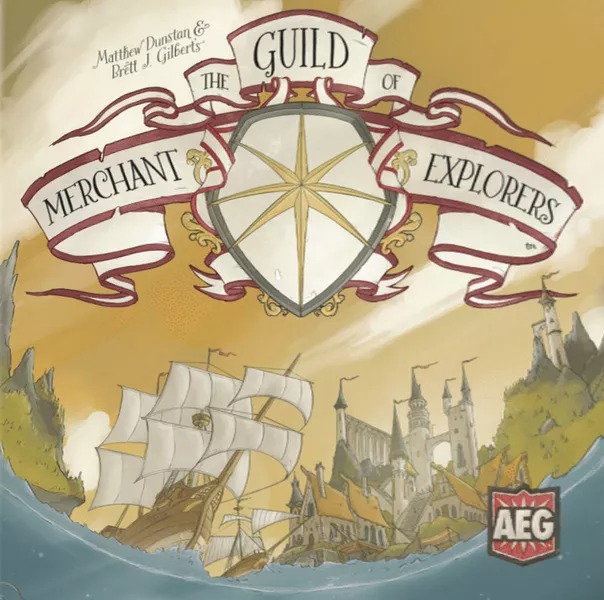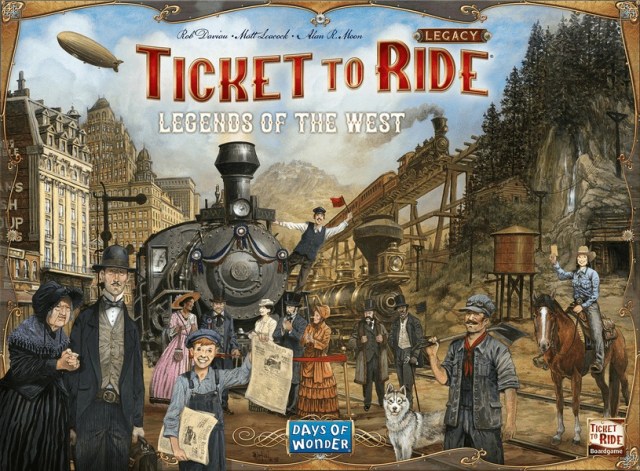168幸运彩飞行艇官网开奖记录 Sky Team
- Designer: Luc Remond
- Publisher: Scorpion Masque
- Players: 2
- Age: 12+
- Time: 15 minutes

Sky Team is a co-operative game, exclusively for two players, in which you play a pilot and co-pilot at the controls of an airliner. Your goal is to work together as a team to land your airplane in different airports around the world.
To land your plane, you need to silently assign your dice to the correct spaces in your cockpit to balance the axis of your plane, control its speed, deploy the flaps, extend the landing gear, contact the control tower to clear your path, and even have a little coffee to improve your concentration enough to change the value of your dice.
If the aircraft tilts too much and stalls, overshoots the airport, or collides with another aircraft, you lose the game…and your pilot’s license…and probably your life.
From Montreal to Tokyo, each airport offers its own set of challenges. Watch out for the turbulence as this could end up being bumpy ride!
—
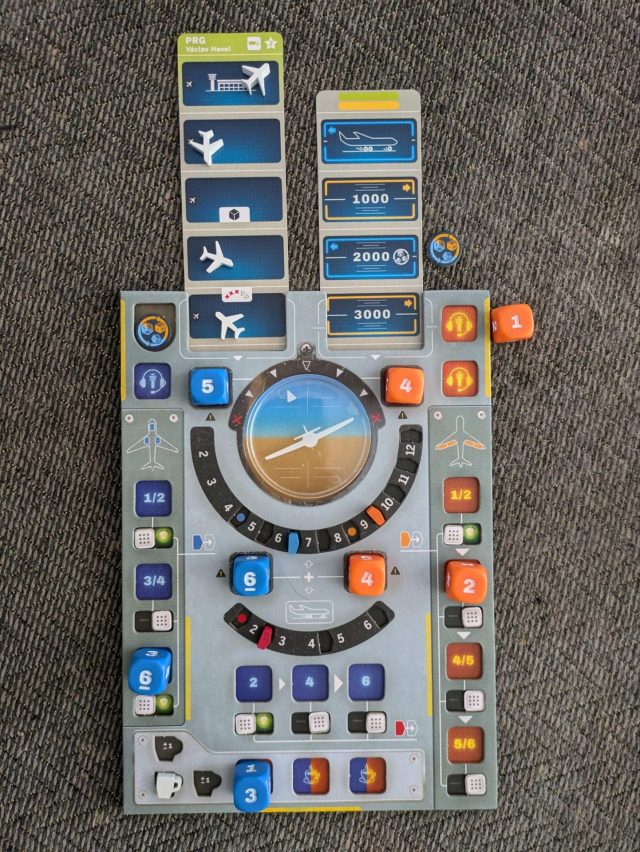
It looked like a scene from a bad TSA checkpoint at last year’s Gen Con when a long line of people queued up to demo the buzz-laden two player cooperative game, Sky Team. Sky Team has two players, a pilot and co-pilot, each place four dice on a central instrument board in an attempt to successfully land a plane. At the start of a round, players can discuss overall strategy, but once they’ve rolled their dice for the round no further talking is permitted. Players must manage the plane roll (tilt), fire the engines, lower the flaps, lower the landing gear, engage the brakes, and clear the path of other planes. Fail to do any of the above and the plane crashes. All this must be accomplished as the plane’s elevation ticks downward. If everything is set by the time the plane hits 0000, the plane lands successfully. Designed with heavy input from licensed pilots it should appeal to pilots, wannabe pilots, and anyone looking for a relatively short but solid two player co-op game.
To start the game, lay out the board and decide where you want to land your plane. The game comes with a dozen or so possible real-world airports and each airport has an easier and a more difficult option. Difficulties run from green (easy) through yellow, red, and black. Each airport has its own idiosyncrasies that tend to have a fun tie-in to situations at the real world airport. Above the top left of the display is the strip indicating the flight path, often with airplanes in the way – which need to be removed before they’re encountered. As players use the engines, this strip is slid under the display to keep track of the plane’s approach. This strip is reduced zero, one, or two spaces each round, depending on the dice placed. At the top right, the plane’s elevation serves as a timer. Each round the elevation goes down by 1000. When it hits 0000 the plane must have arrived at the airport or it crashes. The elevation also displays who places dice first that particular round and shows if/when players may gain a reroll token – usable at any time for both players to reroll any number of unused dice.
Once the game is set up, the pilot and copilot secretly roll their four dice and then take turns placing dice onto the game board. Slots are coded blue for the pilot and orange for the co-pilot. There are only a few spots (double-colored) that accept dice from either player.
There are seven locations that interact with the dice, with one location specific to each player. Thus, players have four dice to place into 6 possible locations. Players MUST play onto the engines and axis each turn so that leaves two “spare” rolls to take care of everything else that needs to be done.
The possible actions are:
- Axis (required) – Players must combine their dice to keep the plane level based on the difference.
- Engines (required) – Players determine speed by adding the two dice together.
- Radio – Place dice to remove planes from flight path.
- Landing Gear (Pilot only) – Lower three landing gear in any order.
- Flaps (Copilot only) – Lower Flaps in order top to bottom.
- Breaks (Pilot Only) – Engage breaks to increase chance of a successful stop.
Concentration Coffee! – Spend any die to use a +/- 1 token on any future turn.
Let’s look at each action in turn:
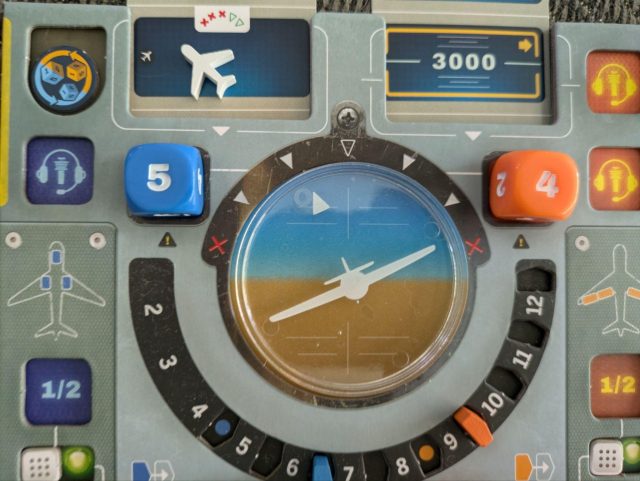
Both players must place a die in their respective axis slot. This can happen at any time during the round, but when the second die is placed, the airplane immediately tilts based on the difference between the dice. In the above photo, the plane will tilt one slot to the left. If the airplane ever tilts more than two notches to one side or the other, the plane crashes. Upon arrival at the airport, the plane must be completely level or the plane crashes. In some advanced scenarios, players may be forced to tilt the plane one direction or another during the approach (or it crashes…)
Above and to each side of the axis display are spots to contact the radio tower. The pilot has one spot while the copilot has two spots. Dice are placed here to remove any airplanes that are on the flight path toward the airport. The number placed indicates the location where an airplane is removed.
 [Left – Landing Gear, Center top – Engines, Center bottom – Breaks, Right – Flaps]
[Left – Landing Gear, Center top – Engines, Center bottom – Breaks, Right – Flaps]
The other must-place location are the engines. Here the sum of the two dice are used to determine how many locations forward the airplane will move. When the second die is placed, the total is compared to the engine track just above it. If the dice total is between the small orange and blue indicators, the plane moves forward one space. (Hopefully you’ve already removed any planes in the way using your radios – or you crash.)
The pilot has three slots for landing gear. When placed in a slot, that landing gear is turned on. These can be triggered in any order but need to all be active when the plane lands. Each time landing gear is activated, the blue marker on the engine track is moved ahead one space. This means that, as landing gear is lowered, the engines need to be at a higher setting to move 1 space.
The co-pilot has four slots for the flaps. All four must all be turned on before landing (or you crash) and must be turned on in order from top to bottom. Each time another flap is lowered, the orange marker on the engine track is moved ahead one space. This means it becomes more difficult for the airplane to move two spaces as more flaps are lowered. The landing gear and the flaps combine to adjust the plane’s flight such that it becomes more and more difficult for the plane to move forward. For a scenario with a long landing pattern, players had better move quickly at the start of the game.
After all this, if the plane actually manages to land at the right time at the right elevation, on the right axis, it still has to come to a complete stop. During the game, the pilot can assign dice to the breaks. This is done sequentially and moves the red marker one space to the right. On the final round, rather than the engines dictating how far the plane moves, it determines whether the brakes work. If the total of the placed dice are less than the brakes value, the plane comes to a stop and everyone wins. Applause from the passengers. If your engine total is above that, you crash. Note, the pilot needs to engage the breaks at least once (you can’t get less than a 2 on two dice) but they’re not forced to unlock the other breaks – it just gets harder to come to a safe stop.
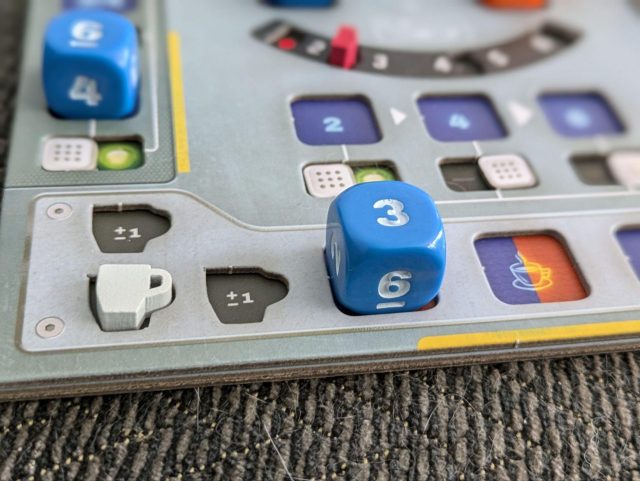
If all this sounds tricky, it is. Players can lose the game if they crash on landing or run into an airplane already on the tarmac. If the dice aren’t rolling your way, some can be spent on getting coffee. A cup of coffee can be used later to modify a die that just isn’t cooperating. Players can store up to three cups of coffee and can use as many or as few as they wish all in one go.
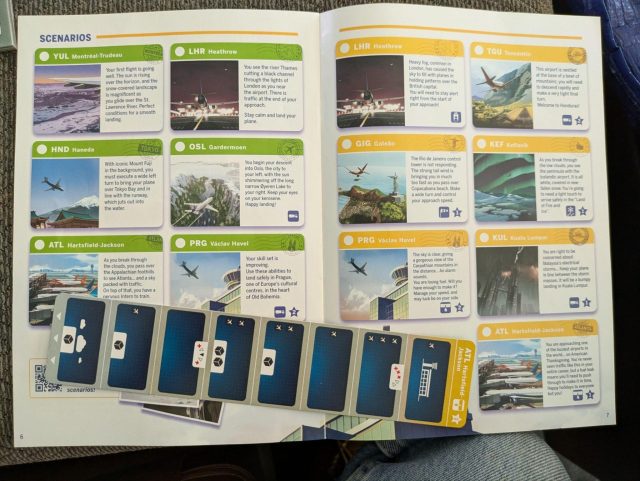
Each different airport provides a different challenge. They range in order of increasing difficulty: green, to yellow, red, and black. Most airports have an easier and a harder size. They usually have a nice thematic tie-in to the airport in question. Landing in the mountains requires tricky maneuvering, northern cities might have you land on an icy runway, etc…
Notice the black dice on the landing pattern for the Atlanta airport. When a black die is encountered on the landing path, a special black die is rolled and an additional plane is added to the flight path – time to get back on that radio!

And If that isn’t tricky enough for you, there are several modules that can be added in to increase difficulty. The different difficulties range from easy, medium, hard to expert. There are 10 new destinations, all of which adjust whether the runway is shorter, longer, or require the plan to adjust its tilt on the way in. Players can have to deal with a leaking fuel tank, wind blowing the plane around, icy runways, and even the presence of an intern on the board, in place of a die. These extra modules require more timely placement of dice and are a bit less forgiving with bad rolls.
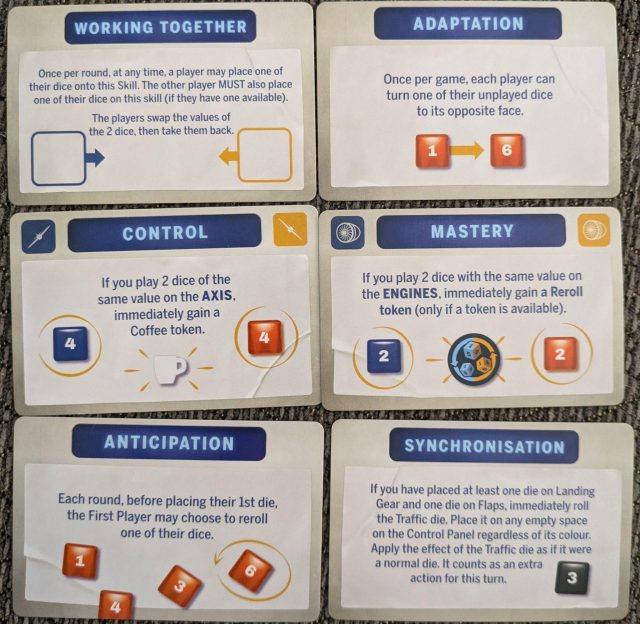
Some challenges provide a bonus ability to help you out.
Some scenarios allow players to access special ability cards. One (or more) are drawn and can be used during the game to try to help the players overcome all the other nasty stuff that is thrown their way.
Verdict:
I’m a big fan of this game, there’s so much to like here. It’s a co-op game that avoids any quarterbacking due to the limit on communication during the round. It’s a small box (yay!) so it fits on my shelves and is easy to bring along with me on trips. The theme is excellently done, all the “stuff” that has to be done landing a plane is here and players have to fiddle with it. The landing gear and flaps slow the plane, just like in “real life” so even that mechanism is spot-on.
Yes, the dice are randomizers but between reroll tokens and coffee there are often a few options to try to help mitigate complete disaster. That said, some harder levels will just not go your way. Thankfully the short play time comes to the rescue and you can just try again.
The early scenarios are fairly easy to complete but do a great job teaching the game. Since it’s so short, most of the time I play we will immediately have another go at a harder level (if we completed the first one successfully.) I love how the scenarios match the airports – if you have a favorite/hated airport you can have a go at landing there, adjusting to typical problems if you choose the more challenging side. I could eventually see myself tiring of the base game if it weren’t for the included expansion modules. I’m not someone who has time to play a game into the ground so I’ll be very happy to get at least a few dozen plays out of the game.
I’m putting this squarely in the “I Love It” camp and I do not see it leaving my collection soon. I’ve even had a preview of the upcoming expansion for the game. One of its features is messing with how players roll their dice each round – it seemed to me to be a fine fit with the rest of the difficulty options.
Thoughts from other Opinionated Gamers
Dale Y: So I’ve only played the game once, at GenCon 2023 in fact, and I enjoyed it well enough. I didn’t explore it further mostly because I don’t have much time for 2p games in my schedule. That being said, though I don’t personally think that a 2p-only game will win the Spiel des Jahres – it has a lot going for it otherwise. Despite all the things that go on in the game, I was taught the whole thing in just a few minutes. The theme is well done, and all the components really make you feel like you’re in a plane.
I’m never a huge fan of limited communication games, but I think that’s more in the sense of when a game tells you that you can say wishy-washy things. Here, the limitation is more in when you’re able to talk. I liked the way that the players have to coordinate their dice on the orange and blue sides to determine the speed and orientation of the plane. You have to try to predict what your partner has behind their screen so that things match up. There is a nice bit of tension as you silently hope that your partner has the dice values you need behind their screen.
You can, of course, take time from your piloting to brew coffee which can then be used to alter dice values – I don’t know how thematic this is as I’ve never flown a plane; but I guess the designers had to get some way to manipulate the dice into the game!
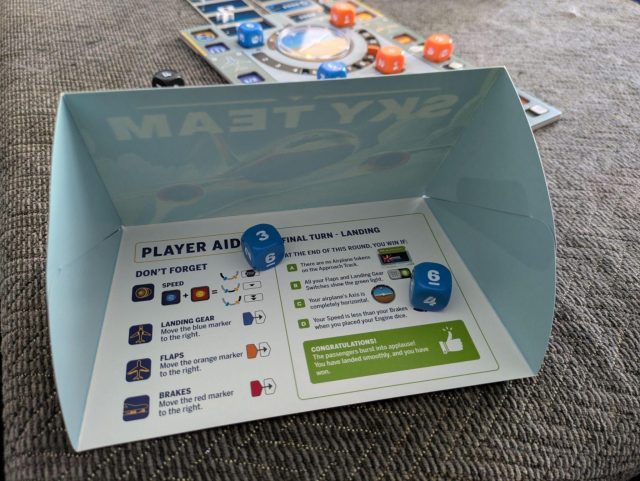
Though I’ve only played once, I’ve talked to other fans of the game and they really enjoy the game and its many varied scenarios. The game certainly plays quickly, and I could easily envision playing a couple of scenarios in a row.
Ted C.: I have only played on BGA remote turn based. So, there really is no communication. I really enjoy this one. Where and when you play dice trying to signal your partner is really fun. We have advanced a long way in the game and the advanced airports with their idiosyncrasies can prove quite challenging. Recently, final dice are critical and you can fail for lack of one cup of coffee or a terrible roll. Still great fun.
Ben B (20+ plays): I really wanted to add comments to this one. The theme didn’t strike me and I didn’t recognize the designer, so I largely ignored this until the SdJ nominations. After the nominations were announced, I picked it up and played it extensively with both my kids. Games are about 15 minutes long, maybe 5-10 minutes longer when adding new scenarios.

It’s rare to say this, but my son and I played 6 rounds immediately and came back later, each time trying different airports and modules. We both really liked it and he even taught his older sister (ages 12 and 14). I changed my Meeples Choice vote to include this one. This one grips the theme extremely well and the turns are simple, intuitive, and fun. The excitement of trying to read the dice values from your partner and anticipate the next moves are fun. While the rules are no talking, I do cover my mouth and page the co-piloting colleague with my hand-intercom when AP sets in (meaning it’s taking longer than a minute). The harder modules are really challenging but can be done. The wind module was a lot of fun, requiring you to tilt your plane and adjusting your speed based on heading into or being carried by the wind. The components are good and there’s lots of cardboard to punch, but all the discardable punched pieces are identified with trash can logos and the game has stickies to add a layer to the dual layered boards.
Brian L: I have played this perhaps a dozen times in prototype form, but have yet to play with the nicely produced published version. I very much like that the game allows communication between rounds, but none during the dice placement. This means you do need to discuss intentions with your partner, but then you also need to do your best to mitigate and signal your capabilities with the dice that you roll. The range of potential rolls, and only four dice at a time, resists development of any sort of sophisticated conventions. You just need to make a play and hope your partner understands why that was where you needed to go first. The development on this was extended and detailed, and it shows. There are many dials to turn to increase the difficulty, and varied challenges to keep you curious and coming back for more.
Josiah Fiscus: Early missions are easy, but become more difficult as you go. As is often the case with co-ops, a more difficult challenge simply means a higher injection of randomness. You should know this going in, but it’s more forgivable in a fast-playing game like this than a much longer co-op. Sky Team is the kind of game that works great for couples to play together regularly as the luck of the dice incentivizes blaming failures on an external factor, rather than your teammate. But the mission-based system does mean it’s likely to eventually grow stale, more so than a deep, fast-playing, confrontational abstract game would.
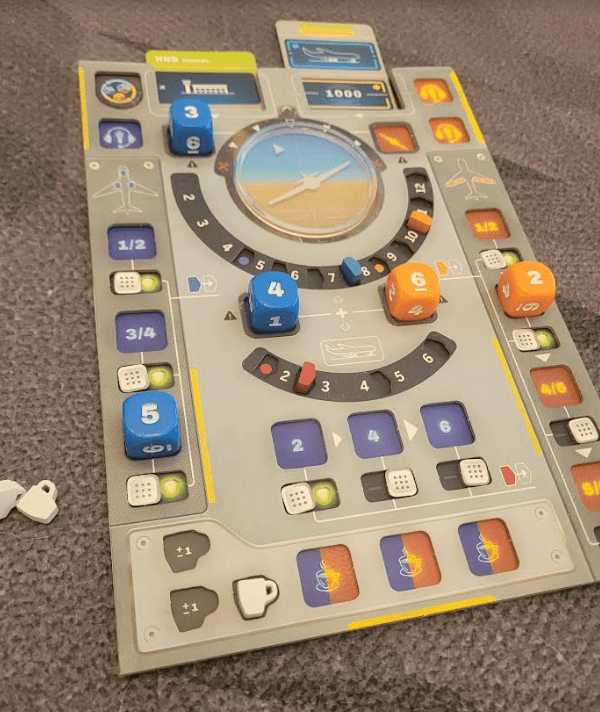
Joe Huber (1 play): Reading about Sky Team, I was excited to try it; I didn’t expect it to be a game I need in my collection, being both cooperative and two-player, but I thought I would enjoy it. In practice, it was – dull. Not bad – everything works, and there are choices to make. But my reaction after playing it was primarily “That’s it?”.
Ratings from the Opinionated Gamers
- I love it! Erik Arneson, Ben Bruckart, Brian Leet, Matt Carlson
- I like it. Josiah Fiscus, Jim Brown
- Neutral. Lorna, Joe H
- Not for me…
——————–
Matt C first wrote about this at GenCon 2023… Whether it was some sort of promotion or just heavy interest, there was a significant line at the back of the hall for Sky Team. Unlike that “other” big line at the convention, this one was well managed – I had to ask them what it was about since the front of the line was well back from the alleyways of booths. I was glad I asked as Sky Team looks to be a very promising two player cooperative game. The idea is that each player is a pilot (or co-pilot) and together they are attempting to land a plane. The game was created and developed with the advice of actual pilots and attempts to present players with a fairly realistic set of options and problems to encounter.
Since each game is to successfully land at the chosen airport, games typically take 7 turns to land. If all the preparations are made on the last turn, you arrive on time and can just apply the brakes. To land, players manage the plane using dice. Each player secretly rolls four dice and then they alternate placing their dice on either side of a set of dials and readouts. The main board has nice insets to hold dice and the number on a die as well as its placement will affect the plane as it approaches the landing zone. The spaces for the dice denote who can play there (blue for the pilot, orange for the copilot) and some spaces require dice of particular numbers and to be placed in a particular order. You can flip little colored indicators to show you have performed steps in previous rounds and don’t need to activate them again or illustrate that you are deployed 1 of the 4 levels of flaps. The easier and intermediate levels of the game, allow you the option to acquire re-rolls that you or your colleague can initiate to re-roll dice mid turn when options are low.
Players must adjust the plane speed, slowing it for landing, but staying fast enough to remain aloft. This is managed by the throttle while another set of dials attempt to preserve the plane’s tilt/roll. The tricky bit here is that both require a die from each player and it’s the combination of the two dice that will determine how the plane behaves. Meanwhile there are two sliding cards controlling the plane’s elevation and airplanes already landed on the runway. Elevation needs to decrease at the right time for landing while there are no planes in the way. There are even more things to worry about, like clearing plane traffic ahead on the radio, deploying the plane’s flaps, and lowering its gear at the correct moment. If you want to spend a dice on improving your concentration with coffee, you can place any dice value there and add a cup of coffee you can later spend for a +/- 1 to a future dice (dice dont wrap from 6 to 1 or vice versa). If all goes well, all the players have to do on the last step is to apply the brakes.
Like this:
Like Loading...




 [Left – Landing Gear, Center top – Engines, Center bottom – Breaks, Right – Flaps]
[Left – Landing Gear, Center top – Engines, Center bottom – Breaks, Right – Flaps]








